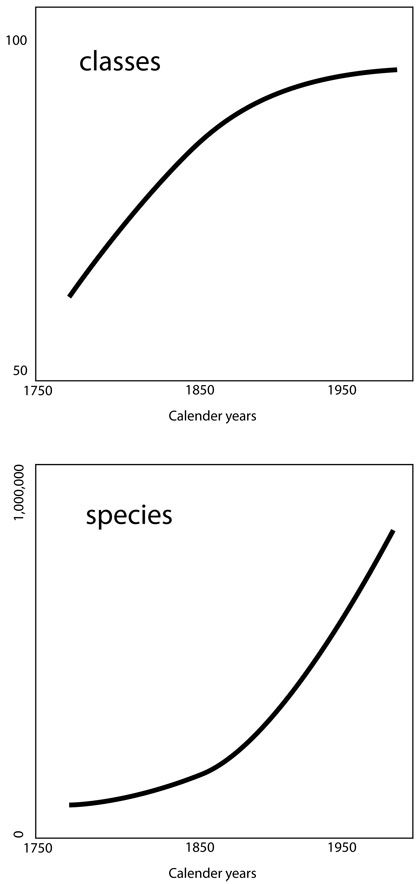November 2011: 8.7 million organisms on the earth?
This essay was motivated by a comment by Daniel Strain in the journal Science [1], which described a research report by Mora et al. in PLoS [2] that makes an estimate of the number of species of animals and plants on earth. May [3] also comments on the report by Mora et al.
The problem
The basic problem is that we don't know how many species of complex animals and plants there are on the earth. We do know that there are many more than we have identified because we find more and more each year. More precisely, the number of new species seems to increase even more rapidly each year. If there are a large number of unidentified species you might expect that the rate of finding new species would depend, among other things, on the number of people that are looking for new species, how clever they are, and the funds they have for travel to the more remote regions of the earth. However, it might be possible to make an estimate of the total number by looking at trends and extrapolating to the final value. But what trends to look at and how do we extrapolate?
A solution
The first pass used by Mora et al. was to look at the number of groups placed in the different taxa over the last 200 years. The idea is that as more and more scientists look at more regions of the earth they will find more and more species (certainly true). As the number of species increases, new genera, new families, new orders, … will also have to be created, because the new species will not all fit into the old taxa. In general, the historical growth of the different levels of taxa is lower for the higher taxa. This makes sense, since if you only have 1 percent of the species, you are likely to be missing most of the families, many of the orders, but only a few of the classes. The higher up you go in the taxa, the more likely you are to have data on at least some of the members of those taxa. However, this pattern assumes that there is some fairly fundamental method that biologists use to split organisms into the different taxa. The survey of the literature made by Mora et al. seems to confirm this, since they found the historical growth of higher taxa slower than lower. The authors then fit curves to the data and estimated a maximum value for each. The second pass used by Mora et al. was to examine the historically extrapolated limits of members of the different levels of taxa as you go down from phyla to species. They found that there was a fairly constant ratio of members between taxa levels, and they then extrapolated this trend to species (which were under represented relative to the other levels). In this way they estimated that there are 8.7 million species, in contrast to the 1.5 million that have been reported.
The politics of science
The authors of these articles are taxonomists, and they make an argument for a greater effort (read funding) to find more species. I certainly agree that a respectable amount of funding should be directed to taxonomy. The only question is how many dollars is respectable. Examination of different organism has often revealed valuable and fundamental insight into basic questions in biology. You can not say that the next new organism might lead to one those insights. However, there are so many other approaches to understanding that also require financial support. I don't think the number species on the earth is such an important parameter. That's just my opinion.
See [4] for a modern perspective of taxomy.
Diversity and species
The exact number of species is perhaps not as important as the recognition that there are many that have not been identified. It is perhaps even more important to realize that the diversity of life is many factors of ten greater than the number of species. After all, even modern humans, Homo sapiens, are a diverse collection of animals. Each of us (except for identical twins) differs by thousands of nucleotides from all other humans. Some of these differences make a big difference, some may make no difference. As another example of diversity , I mention on page 139 of "Life on the Dock" that the DNA sequences of different schools of salmon are characteristic of their spanning locations, even though the fish in the different schools are not distinguishable in appearance, and so are considered the same species.
Note that no mention has been made of the bacteria and archaea. It is these two kingdoms that contain the greatest diversity, and perhaps the greatest number of species. However, the diversity is so great in these kingdoms that the concept of species may be irrelevant.
References
[1] 8.7 million: A new estimate for all the complex species on earth: Strain. Science (2011) v333, p1083
[2] Why worry about how many species and their loss?: May. PLoS Biology (2011) v9, issue 8, e1001130
[3] How many species are there on earth and in the ocean: Mora et al. PLoS Biology (2011) v9, issue 8, e1001127
[4] Introduction to "Taxonomy for the Twenty-first Century": Godfray and Knapp. Phil. Trans. R. Soc. Lond. B (2004) v359, p559
